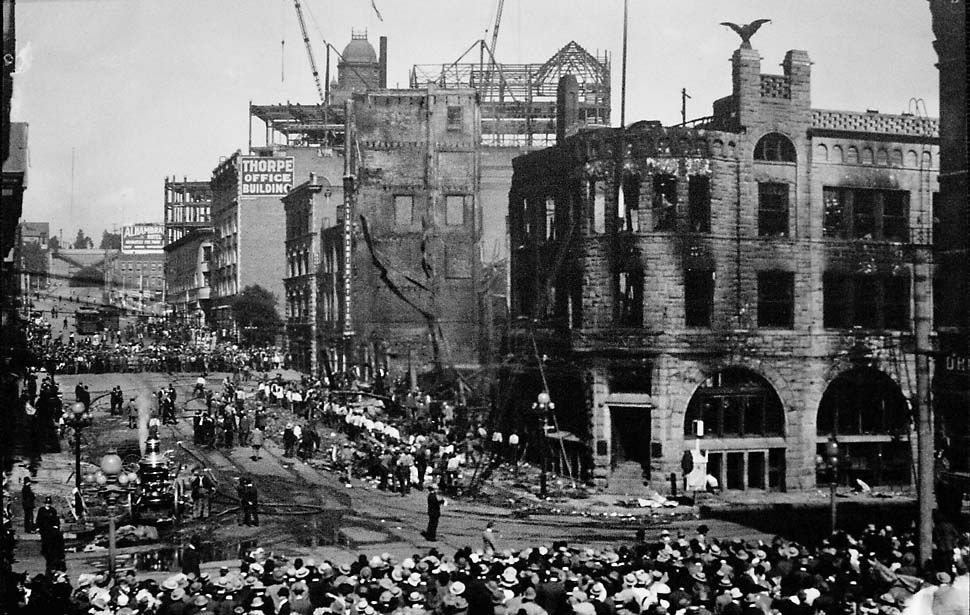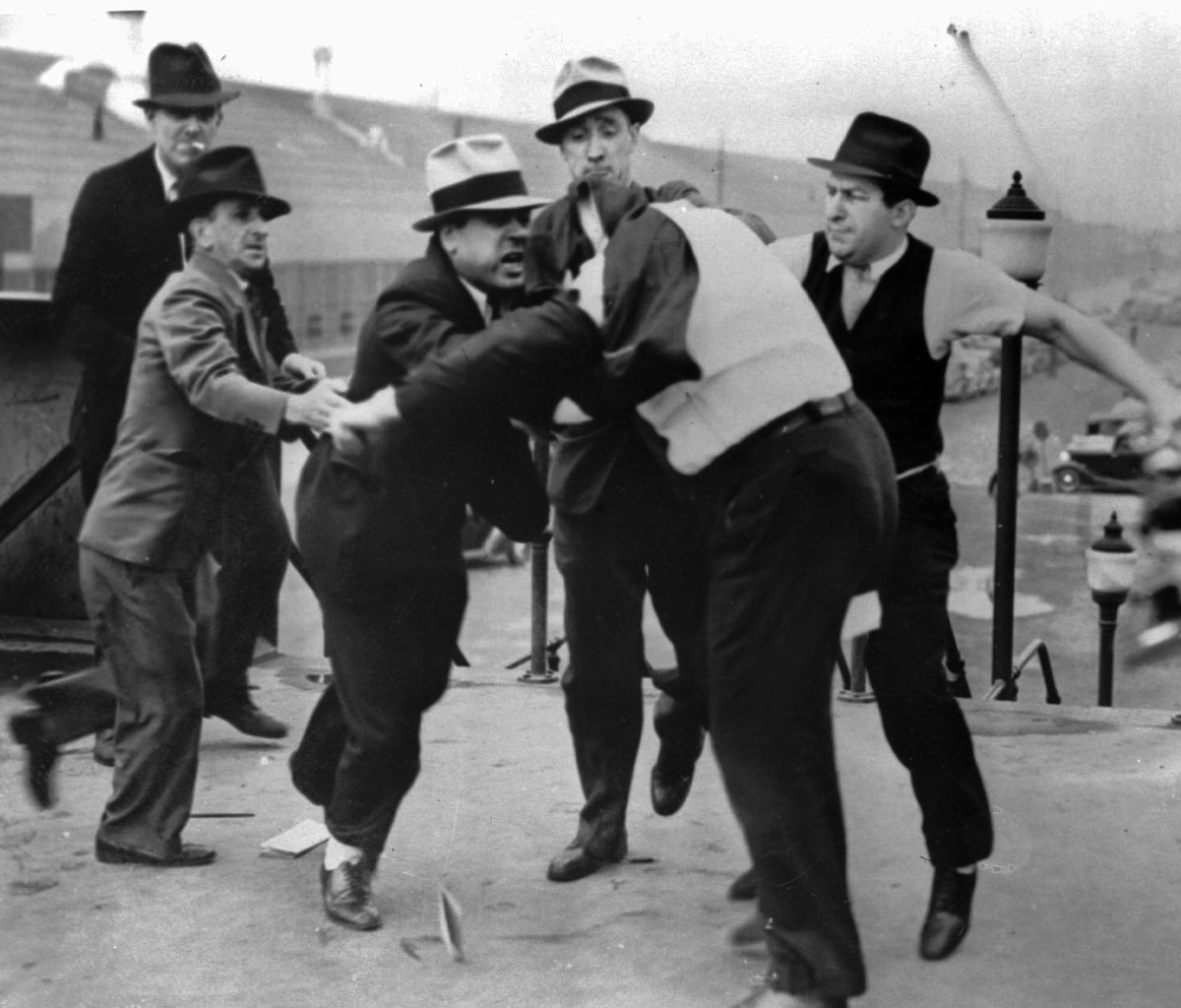This Day in Labor History: October 1, 1910. International Association of Bridge and Structural Iron Workers member James McNamara blew up the Los Angeles Times building because the paper’s publisher, Harrison Gray Otis, was so anti-union! 21 died. Let's talk about this! 

In the early 20th century, Los Angeles was arguably America’s most conservative city. An hotbed of anti-union extremism, organized labor was almost entirely nonexistent. No one did more to push this policy than Harrison Gray Otis.
In 1896, Otis took over the city’s Merchants Association and turned it to an virulently anti-union organization. Using his powerful newspaper as a mouthpiece for antiunionism, Otis spent the next two decades as the nation’s most important anti-union advocate.
Some of this was ideology, some of it was LA boosters trying to undermine unionized San Francisco as the center of the California economy.
The Iron Workers were a tough bunch of unionists, to say the least. Formed in 1886, the union remained weak until it won a strike against a U.S. Steel subsidiary in 1902.
This opened the door to them and within a year had most of the nation’s iron shops under their control, even signing some collective bargaining agreements with employers.
In 1903, US Steel struck back, organizing the nation’s iron industrialists for a concerted union busting campaign that included spies, state complicity, and violence against workers. It was successful and by 1910, the union was out of every US Steel facility and most others.
Responding to this campaign, beginning in 1906, the Iron Workers started using bombs to force companies to the bargaining table. Mostly this was just showing companies what they could do–the total damage of all these 110 bombs was small.
But they did know how to manufacture and detonate bombs, that was for sure. No Alexander Berkman were these men.
During this tumult, a pair of Irish brothers named John and James McNamara rose into the Iron Workers’ leadership. John became Secretary-Treasurer of the union in 1905 and was heavily involved in the bombing campaign.
In 1910, the Iron Workers launched a major organizing campaign in Los Angeles. They wanted a minimum wage of 50 cents an hour and overtime pay. Otis led the opposition. He and his employers organization raised $350,000 to fight the strike.
A court judge issued injunctions that banned picketing. The Los Angeles City Council passed an ordinance banning picketing or “speaking in public streets in a loud or unusual tone.”
The strikers refused to follow these absurd laws and 472 were arrested. The strike was going pretty well and the total number of union members went up by 60%.
Yet on October 1, a bomb went off under the LA Times building. It was supposed to explode at 4 a.m. in order to not hurt anyone but the faulty timing mechanism set it off just after 1, meaning people were still working, including a bunch of reporters finishing a story late.
Most of the dead were killed by the fire caused by the explosion.
The next day, unexploded bombs were found underneath Otis’ home, as well as other sites around the city, although many claim that these were probably planted by the police to frame the union, an entirely possible scenario regardless of who bombed the actual building.
Otis immediately claimed the unionists had blown up his building.
He wrote in the Times, “You anarchic scum. You cowardly murderers, you midnight assassins, you whose hands are dripping with the innocent blood of your victims, have committed one of the worst atrocities in the history of the world.”
Unionists on the other hand believed Otis dastardly enough to bomb his own building just to frame the union.
Samuel Gompers immediately denied that any union was involved in such a dastardly crime. But a spy placed in the Iron Workers Union found out that the bombing campaign had come straight from the union’s top leadership.
A hotel clerk recognized a photo of John McNamara, confirming he had rushed in and out of the hotel just before the bomb exploded. On April 13, James McNamara and Ortie McManigal, a rank and file union member, were arrested in Detroit with bombing equipment on them.
They were taken to Chicago where instead of going to the police station they were held for a week in the home of a police sergeant.
McManigal finally spilled the beans and implicated the entire Iron Workers leadership in the bombing. John McNamara was also discovered to have bombed a local iron manufacturing plant.
The labor movement was infuriated with the treatment of the prisoners, hiding them in a private home and forcing a confession. McNamara and McManigal claimed they had been tortured by the private investigators.
For labor, this felt like the 1906 case when IWW leader Big Bill Haywood and other labor leaders were framed for the murder of former Idaho governor Frank Steunenberg. Clarence Darrow took the defense case.
But it was so clear they were guilty that an ailing Darrow could do little for them. The writer Frank Norris got the brothers to confess in prison and convinced them to make their case that it was a justifiable bombing campaign.
Seeing an inevitable defeat in court, Darrow got Otis and the AFL to agree to a plea bargain that would give the McNamara brothers light sentences in return for the end of the Iron Workers strike, which was ultimately what Otis wanted to begin with.
But although Otis and the business community agreed to this, the prosecutor refused and the trial went forward with the stipulation that James would receive life and John a shorter sentence.
That final plea agreement also stipulated a meeting between capital and labor and the end of the employers’ open shop campaign.
When Gompers found out the McNamara’s had pleaded guilty, he said they “had betrayed labor.”
James McNamara received life in prison. John received 15 years. Thirty-eight Iron Workers were convicted of various crimes. The employers completely ignored their side of the agreement and continued fighting any unionization in their conservative town.
The bombing convinced national labor reformers to push for a greater government role in labor relations so that violence could be avoided. This led to the remarkable U.S. Commission on Industrial Relations, created by President Taft in 1912 that would truly investigate employers.
The entire Los Angeles labor movement collapsed. Harrison Gray Otis almost couldn’t have asked for a better gift. Los Angeles remained a city with unusually low union density until the 1950s.
Ortie McManigal served 2 1/2 years as part of his plea deal. James McNamara died in prison in 1941. John McNamara served his full 15 years. Upon his release, he returned to union organizing, dying in Butte 2 months after his brother.
Back on Sunday to discuss the 1978 Ellis Prison strike, where workers in Texas said no to forced labor.
• • •
Missing some Tweet in this thread? You can try to
force a refresh










